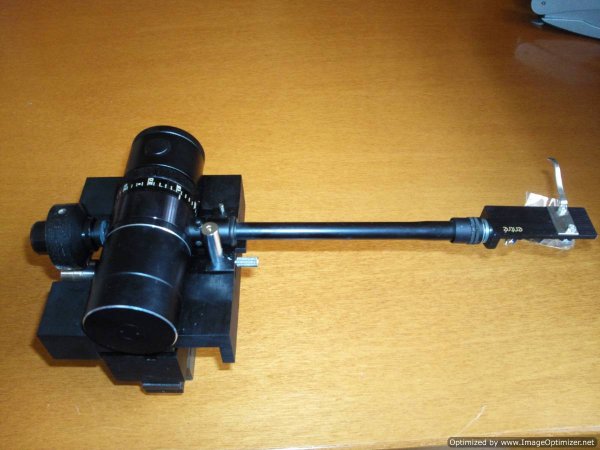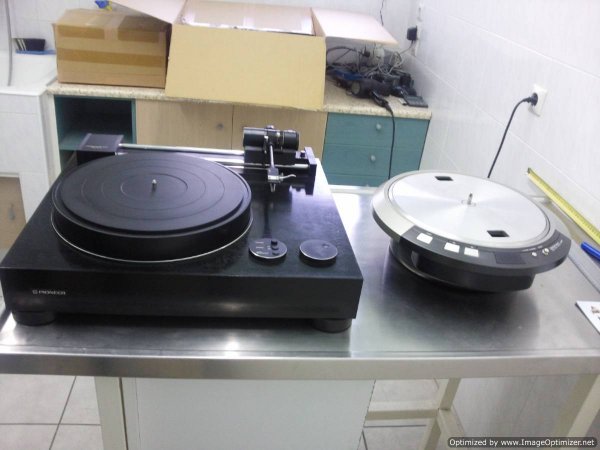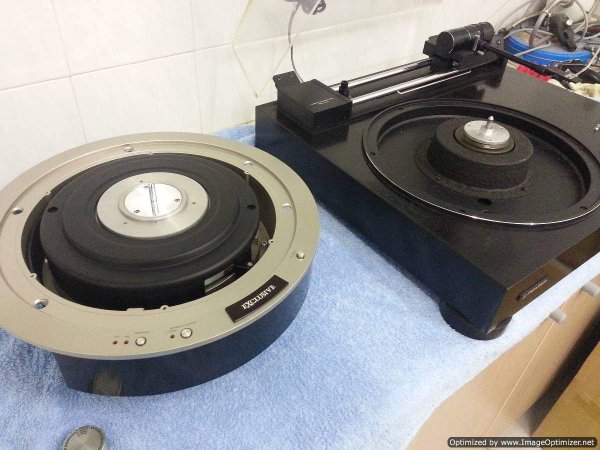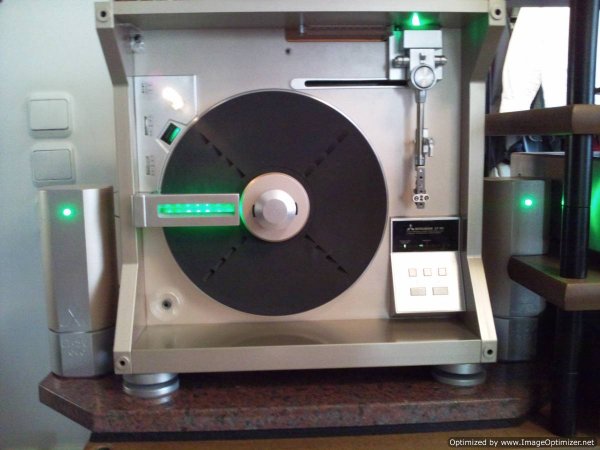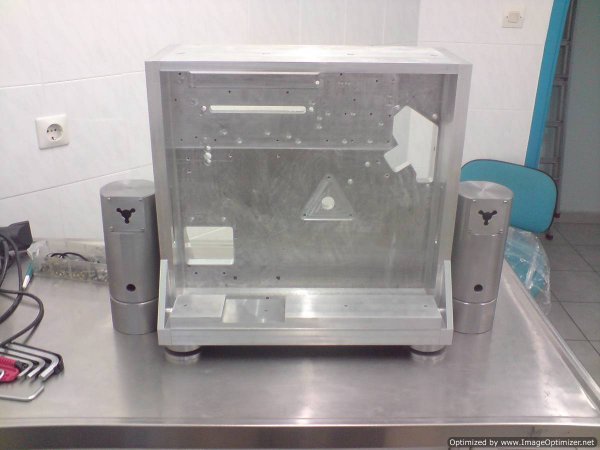Linear-tracking Turntables!
- Thread starter Johnny Vinyl
- Start date
You are using an out of date browser. It may not display this or other websites correctly.
You should upgrade or use an alternative browser.
You should upgrade or use an alternative browser.
X- sounds like you know a little bit about these old telescopes. And you just joined (welcome). Can you post any pics of the scopes you are describing as mounted? Are you into things audio as well?This Warner Swasey telescope looks in great shape, at least the parts do. There is a lot of brass there and of different composition/colors. It is very interesting to see the two different gears on the right, the finder scope holders and so much more. The main person in charge of the design of the telescopes at Warner & Swasey (Cleveland Ohio) was Gottliebe Fecker, later on helped by his own son J.W.Fecker. Much later J.W.Fecker started his own company and the "legacy" of the Warner Swasey telescopes lived on with the Fecker telescopes. The optics was usually made somewhere else. I am myself working on restauring a J.W.Fecker telescope, manufactured 50 years ago. It is a reflecting 15 inch Cassegrain. Usually the reflecting telescopes (which are more modern) are mounted on a "fork", this one however is mounted on an equatorial mount. What is more surprizing is that the equatorial mount looks very similar to the older Warner Swasey equatorial mount. The entire telescope was originally painted (everything!) and as I started removing the paint I discovered two brass wheels and additional pieces (gears) made of brass. I suspect that the equatorial mount was possibly made using older existing pieces. I have seen only very few reflecting telescopes mounted on such an old equatorial mount. In the older Warner Swasey telescopes the brass is never painted, especially the brass wheels. I believe the telescope you are showing is also mounted on an (german) equatorial mount made of solid iron with a mechanical clock situated in the box below the mount itself. Are you refurbishing the telescope and the mount and the clock? or just the scope itself? It is a very interesting project. Thanks for sharing that with us.
Wow, that's quite massive. at least the platform is. Aside from interest in antiquity, what is the quality of the optics from something that old? (I gather that part of the magic of old Leicas is the optics, but that's not my area, so I'm curious).Thanks. The scope right now is in pieces as I have been working on it (and I still have a lot to do).
The only audio I am in is restauring an antique radio using parts from another old radio (you know
these radios with bulbs in them; I also got some video cameras with "tubes" rather than modern CCDs).
Here is a picture of that Fecker telescope (fully equipped) taken some years ago. As you see everything
is painted, including some of the pieces (wheels and more) made of brass. View attachment 6422
And is that rig set up in a home? Pretty serious- private observatory!
Wow, I had no idea he could be like that.and Mr. Jarrett apparently knows a thing or two about insanity and obsession:
http://www.allaboutjazz.com/php/article.php?id=26493
I'm getting excited about fixing the Pioneer PL-1000 with tangential tonearm I have after reading several pages of this thread.
A contribution if not already mentioned...........a hybrid of sorts.
http://www.audioasylum.com/audio/vinyl/messages/90/905007.html
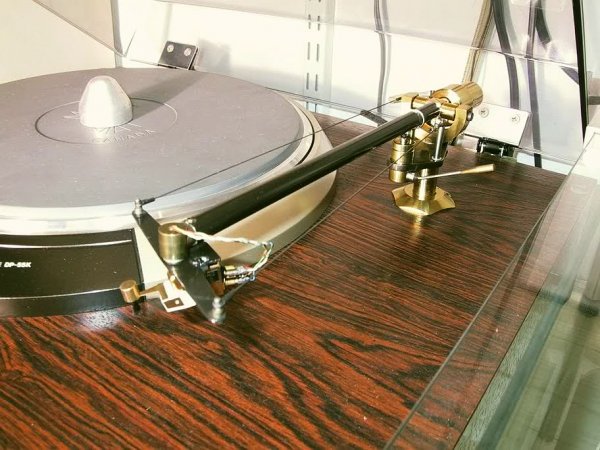
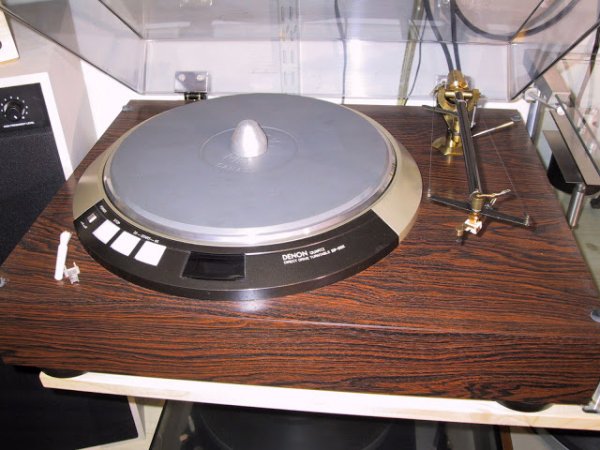
Great link beek.
.......... being a physicist
Just a little bit of the mad scientist in you? Love the energy coming off of that work bench.
Last edited:
This is great!
Keep the photo coming, it remind me the good old day,s when HiFi was fun and David Hafler involved!
Keep the photo coming, it remind me the good old day,s when HiFi was fun and David Hafler involved!
servo vs air bearing: how was the mass problem solved?
A friend of mine and audio manufacturer adopted the Sony PS-X800 as his favorite table while it was still a current model. He decided then, and nothing he's heard since (including his audio customers, endless audiophile friends, trade shows, etc.) has changed his mind, that it is the best table ever. He sold me on the table (though I am not making his claims about it!) so that I had a used one from audio mart about 1987, and used it to varying degrees. I've also had Linn Sondek LP12 Valhalla/Ittok, and I preferred the Sony. It was when the Sony first broke for me that I got the Linn, though used it was set up by a Linn dealer who declared it perfect. I used the Linn for awhile, but I also have philosophical differences with the table in many ways, the felt mat, the lack of clamping, the halting startup, etc. So I was glad to the get the Sony fixed, and it served my not very intense usage (copying a number of out-of-print recordings mainly, sometimes showing off how good records could sound). Then the Sony broke again, and it was back to the Linn for about three years, then it broke (for the second time for me actually, the first time I just took it to the dealer and he replaced the Valhalla diodes or whatever, with barely a week out of service, and said he used better ones that would not break, but now the dealer is 80 miles away, and I didn't even know he was still in business until a few months ago, and it broke 2 years ago.)
Anyway, recently I decided I had not fully appreciated or remembered how much I appreciated vinyl, perhaps analog really is better even than the best high rez digital, and I've started collecting new tables, spinning vinyl, and working on improving the tables. But that's another story.
The story here is that my manufacturer friend back in the 1980's showed me a paper copy of something called the Katz Report. And it discussed linear tracking turntables up to about 1980 in a longwinded article. And it basically declared that only something like the Sony had a chance of working properly. It claimed that the problem with any mechanical linear tracking system is that it requires the stylus to move too much mass: the base of the tonearm, for which the stylus has no advantage of leverage (as it would in a pivoted arm). No matter how much you reduced the friction, you could not solve the problem regarding having the stylus move so much mass.
Well I think my friend still takes this as the final word on linear tonearm engineering. But I have noticed many other linear turntables working for people, and often getting high praise, and I suspect these people using them aren't all idiots or dupes (strange how many of my audiophile friends think that anyone who buys a statement turntable or the like must be an idiot, because everyone knows something…), so they somehow must have "solved" the problem Katz was talking about, or it wasn't actually a problem in the first place.
To the air bearing arm, for example, I suspect the air system must actually assist motion, so that a push on the arm causes it to be driven by the air slightly, therefore solving the alleged mass problem.
But as much as I read about new linear tonearms, no where do I ever see this spelled out. Is it because (a) they don't actually use air assist, or (b) they don't really want to talk about it, because it sounds a bit like servo, and that would be bad for marketing?
To be fair, air assist could be made very exact, with little delay, even added damping, etc, far moreso most crude servo arms, though the PX-800 is actually a bit special, using hall effect sensors as part of a very complex electronic system which not only tracks but damps resonances in both axes, and pretty much keeps up with inward motion and record off-centeredness perfectly, so nearly perfect tangency is nearly always maintained, about as far as you can see, at least when it works).
A friend of mine and audio manufacturer adopted the Sony PS-X800 as his favorite table while it was still a current model. He decided then, and nothing he's heard since (including his audio customers, endless audiophile friends, trade shows, etc.) has changed his mind, that it is the best table ever. He sold me on the table (though I am not making his claims about it!) so that I had a used one from audio mart about 1987, and used it to varying degrees. I've also had Linn Sondek LP12 Valhalla/Ittok, and I preferred the Sony. It was when the Sony first broke for me that I got the Linn, though used it was set up by a Linn dealer who declared it perfect. I used the Linn for awhile, but I also have philosophical differences with the table in many ways, the felt mat, the lack of clamping, the halting startup, etc. So I was glad to the get the Sony fixed, and it served my not very intense usage (copying a number of out-of-print recordings mainly, sometimes showing off how good records could sound). Then the Sony broke again, and it was back to the Linn for about three years, then it broke (for the second time for me actually, the first time I just took it to the dealer and he replaced the Valhalla diodes or whatever, with barely a week out of service, and said he used better ones that would not break, but now the dealer is 80 miles away, and I didn't even know he was still in business until a few months ago, and it broke 2 years ago.)
Anyway, recently I decided I had not fully appreciated or remembered how much I appreciated vinyl, perhaps analog really is better even than the best high rez digital, and I've started collecting new tables, spinning vinyl, and working on improving the tables. But that's another story.
The story here is that my manufacturer friend back in the 1980's showed me a paper copy of something called the Katz Report. And it discussed linear tracking turntables up to about 1980 in a longwinded article. And it basically declared that only something like the Sony had a chance of working properly. It claimed that the problem with any mechanical linear tracking system is that it requires the stylus to move too much mass: the base of the tonearm, for which the stylus has no advantage of leverage (as it would in a pivoted arm). No matter how much you reduced the friction, you could not solve the problem regarding having the stylus move so much mass.
Well I think my friend still takes this as the final word on linear tonearm engineering. But I have noticed many other linear turntables working for people, and often getting high praise, and I suspect these people using them aren't all idiots or dupes (strange how many of my audiophile friends think that anyone who buys a statement turntable or the like must be an idiot, because everyone knows something…), so they somehow must have "solved" the problem Katz was talking about, or it wasn't actually a problem in the first place.
To the air bearing arm, for example, I suspect the air system must actually assist motion, so that a push on the arm causes it to be driven by the air slightly, therefore solving the alleged mass problem.
But as much as I read about new linear tonearms, no where do I ever see this spelled out. Is it because (a) they don't actually use air assist, or (b) they don't really want to talk about it, because it sounds a bit like servo, and that would be bad for marketing?
To be fair, air assist could be made very exact, with little delay, even added damping, etc, far moreso most crude servo arms, though the PX-800 is actually a bit special, using hall effect sensors as part of a very complex electronic system which not only tracks but damps resonances in both axes, and pretty much keeps up with inward motion and record off-centeredness perfectly, so nearly perfect tangency is nearly always maintained, about as far as you can see, at least when it works).
Because the arms are “fussier” to set up and maintain than their pivoted brethren. Pivoted arms are almost the analog equivalent of digital’s “look ma, no hands” approach in comparison to linear tracking arms.
I just read and even understood most of the 130 posts so far.
1. liners cost more (thats almost a plus in this hobby)
2. liners are harder to set up ( that is not a plus)
3 liners have better bass (yes or no)
4 crabing may be a problem (Are people using liners getting less cartridge life)
5. Air pumps and tanks are a pain messy lines too loud.
6. Pivoted arms are getting far more R&D than Liners.
7. liners put more stress on a styles than a pivot (again what is a styles or cartridge life on a liner compared to a pivot of similar quality)
8. Liners make changing a record harder, easier about the same
9. audiophiles are to Lazy to use liners (Guys who sit on their buts for hours in the dark are Lazy NO WAY)
10. Is a liner more trouble than the gains it gives. ( yes or no )
Never owned a liner never used one , I have never been in a audio store that had one set up and running. I was at RMAF and saw Walker himself set the needle down and it took off across the record like a cat with its tail on fire. Thats when I thought I will stay with my Lazy old tri planner. Walkers table sounds great when the needle one time only does not come out of the groove. But it did happen
This thread is a good read and lazy or not their is more than one way to do it right IMO
done properly, parallell tracking arms are unbeatable
everything else is a compromise imo
btw mine is easier to set up than anything else; just need a template with a thin red line from turntable spindle and adjust overhang so the needle follows the line from center to outer rim of LP
that´s it
best
Leif
everything else is a compromise imo
btw mine is easier to set up than anything else; just need a template with a thin red line from turntable spindle and adjust overhang so the needle follows the line from center to outer rim of LP
that´s it
best
Leif
done properly, parallell tracking arms are unbeatable
everything else is a compromise imo
btw mine is easier to set up than anything else; just need a template with a thin red line from turntable spindle and adjust overhang so the needle follows the line from center to outer rim of LP
that´s it
best
Leif
Thanks for the reply I like what you say about set up . What arm is it how long have you used it .
done properly, parallell tracking arms are unbeatable
everything else is a compromise imo
btw mine is easier to set up than anything else; just need a template with a thin red line from turntable spindle and adjust overhang so the needle follows the line from center to outer rim of LP
that´s it
best
Leif
I'm sorry Leif but "if properly" done leaves a lot of wiggle room. That's the in theory but in reality loophole.
There's always going to be some inherent compromise in a linear tracking arm eg. ability to maintain tangency to the groove, horizontal vs. vertical mass, sticking or crabbing, length of the arm, tightness, solidity and energy transfer in the bearing, smoothness/turbulence of air flow and number of "holes" in the air bearing (oh yes, God help you if the air flow quits in the middle of playing and the cantilever snaps!), maintenance issues, etc. I think Mike summed it up very nicely.
And yes it's a compromise. The best air bearing I've ever heard was an Air Tangent arm and it excels at retrieving information out of the groove and the recording's ambience. But it can't touch a pivoted arm when it comes to low end response.
Even a bit late...here's my 2c on the subject.
I love tangential arms.I use them from day one...that is 1983.
My cartridges last forever and my records sound very well preserved for some reason...?
I have heard a lot of other arms but in some way they don't cut it for me.
Maybe my ears and brain are too biased after so many years of getting used to the tangential sound...
Just like ribbon tweeters...i like nothing else.
(Oops...they all do have a sound, like anything in audio)
On the other hand i have access to Kuzma's air driven tangential arm and have heard the LFT arm...very good but all this paraphernalia that is needed to make it work is a turn off for me...even though complexity doesn't hurt me on other departments of audio gear.
And "me too" i wouldn't touch the Clearaudio tangentials...
My turntables use servo driven arms, both use tiny pivoting sensors to always keep the arm straight but move the arm carrier with different techniques...they both work veeery well.
IMHO servo is not an anathema if properly executed.
Each one has it's good and bad points (these i have tried to fix within my brain and financial power).
Very proud of owning both, extremely happy with their sound and i'm not looking for something else.
Here they are:
I love tangential arms.I use them from day one...that is 1983.
My cartridges last forever and my records sound very well preserved for some reason...?
I have heard a lot of other arms but in some way they don't cut it for me.
Maybe my ears and brain are too biased after so many years of getting used to the tangential sound...
Just like ribbon tweeters...i like nothing else.
(Oops...they all do have a sound, like anything in audio)
On the other hand i have access to Kuzma's air driven tangential arm and have heard the LFT arm...very good but all this paraphernalia that is needed to make it work is a turn off for me...even though complexity doesn't hurt me on other departments of audio gear.
And "me too" i wouldn't touch the Clearaudio tangentials...
My turntables use servo driven arms, both use tiny pivoting sensors to always keep the arm straight but move the arm carrier with different techniques...they both work veeery well.
IMHO servo is not an anathema if properly executed.
Each one has it's good and bad points (these i have tried to fix within my brain and financial power).
Very proud of owning both, extremely happy with their sound and i'm not looking for something else.
Here they are:
Attachments
Last edited:
I have used a Goldmund T3f arm for decades. It has all the benefits of a parallel tracker and the advantages of a pivoting arm in terms of friction and effective mass.
I have used a Technics SL15 which is a relatively low cost TT but works well. I have a B&O 8002 which has a lot of innovative engineering in it, not just the arm.
Record players are always a compromise and each individual will have to chose their own combination of compromises. This will depend on price and the combination of colourations they prefer. The whole thing is, after all, to produce a convincing illusion to the listener and different things are convincing to different people.
As an ex turntable R&D engineer the one thing i am sure of. Today many of the expensive TTs are styling excercises and the very best TTs performance wise are not all expensive and a lot of the expensive ones have little extra to add, other than looking impressive and the reassurance of being expensive.
IME
I have used a Technics SL15 which is a relatively low cost TT but works well. I have a B&O 8002 which has a lot of innovative engineering in it, not just the arm.
Record players are always a compromise and each individual will have to chose their own combination of compromises. This will depend on price and the combination of colourations they prefer. The whole thing is, after all, to produce a convincing illusion to the listener and different things are convincing to different people.
As an ex turntable R&D engineer the one thing i am sure of. Today many of the expensive TTs are styling excercises and the very best TTs performance wise are not all expensive and a lot of the expensive ones have little extra to add, other than looking impressive and the reassurance of being expensive.
IME
Hi, just found this forum and this topic. Will read all the way through when I have more time as it's getting late.
Current TT is a Yamaha PX-3 with a AT120e cartridge. Sitting in a box to be cleaned and serviced is a working Pioneer PL-L1000. As you can see, I am a firm believer in linear tracking TT.
Picked up a screaming deal on a Sota Saphire with a Souther linear arm and wheeled and dealed it away quickly for a nice set of Carver M500T amps. That thing was just to delicate and fiddly for my liking.
With the Yamaha I just pick up the cover, place a record, lower cover and hit a button. Perfect tracking every time. And the sound.............
BillWojo
Current TT is a Yamaha PX-3 with a AT120e cartridge. Sitting in a box to be cleaned and serviced is a working Pioneer PL-L1000. As you can see, I am a firm believer in linear tracking TT.
Picked up a screaming deal on a Sota Saphire with a Souther linear arm and wheeled and dealed it away quickly for a nice set of Carver M500T amps. That thing was just to delicate and fiddly for my liking.
With the Yamaha I just pick up the cover, place a record, lower cover and hit a button. Perfect tracking every time. And the sound.............
BillWojo
Well there was the Dennis Shreve mod for the Rabco and it did serve as the inspiration for the Goldmund arm (that was also a nightmare to set up, align and get to work properly; tangency was an issue early on with the Goldmund arms). But when set up right, it did sound quite good. It worked quite nicely with the Spectral cartridge way back then.
Dave Shreve... He's still around, by the way. I see him every time I attend RMAF. He is also still modding the Rabco. There is a current thread about that arm on another forum, and he has been making some posts there.
Picked up a new addition today, a Technics SL-M3! Was missing the cartridge and clear plastic stylus guard on the back of the platter. Anyone have pics of that piece? I doubt I'll ever find a used one. I put on a cheapo AT P-mount cartridge to test it, still sounded pretty good.
BillWojo
BillWojo
Well I picked up a Shure M92e cart and put a new N97xE stylus on it for my Technics SL-M3. I had to make a small adjustment on where the stylus drops into the lead in groove so I had the cover off of the linear arm mechanism. With the cover off I could watch the motor drive for the linear advance mechanism.
There is a double reduction gear system in place. First is a pulley arrangement between the motor shaft and the worm screw. The worm screw than drives a worm gear for very high reduction. Attached to the worm gear is a drum that drives a cable attached to the arm sled. This cable is held in tension as it's attached to the drum at one end, goes to the sled where it's attached and goes further down where it wraps around an idler and returns to the main drum. A spring in the cable keeps the cable taught.
As I played several records I watched the drive mechanism and I could see that the pulley on the worm rotated about 1/4 turn for every rotation of the platter. The motor shaft rotated about a whole turn as it's pulley is much smaller.
So if I recall, the spacing on the record grooves is about 0.003 inches or 0.075 mm. So all this crabbing that your talking about is in the range of a few thousands of an inch.
The tone arm pivots effortlessly just as a pivot arm does except the carriage is advanced as soon as the photo detector indicates it has pivoted out of range, the whole width of one groove!
There is no more side force on the stylus than would be found on a pivot arm. Antiskate is not necessary on a linear tracker.
So what are all of the disadvantages of a well engineered servo controlled linear tracker? As far as I can see from an engineering point of view it is simply the most accurate system that was ever built if done right. And there are a few high end servo controlled LT turntables where it was done right.
BillWojo
There is a double reduction gear system in place. First is a pulley arrangement between the motor shaft and the worm screw. The worm screw than drives a worm gear for very high reduction. Attached to the worm gear is a drum that drives a cable attached to the arm sled. This cable is held in tension as it's attached to the drum at one end, goes to the sled where it's attached and goes further down where it wraps around an idler and returns to the main drum. A spring in the cable keeps the cable taught.
As I played several records I watched the drive mechanism and I could see that the pulley on the worm rotated about 1/4 turn for every rotation of the platter. The motor shaft rotated about a whole turn as it's pulley is much smaller.
So if I recall, the spacing on the record grooves is about 0.003 inches or 0.075 mm. So all this crabbing that your talking about is in the range of a few thousands of an inch.
The tone arm pivots effortlessly just as a pivot arm does except the carriage is advanced as soon as the photo detector indicates it has pivoted out of range, the whole width of one groove!
There is no more side force on the stylus than would be found on a pivot arm. Antiskate is not necessary on a linear tracker.
So what are all of the disadvantages of a well engineered servo controlled linear tracker? As far as I can see from an engineering point of view it is simply the most accurate system that was ever built if done right. And there are a few high end servo controlled LT turntables where it was done right.
BillWojo
tomelex, I agree 100%. I can only imagine if company's like Technics, Sony, Mitsubishi and others were still competing against each other like they were back in the 80's. The state of servo controls and electronics have changed quite a bit since than for the better. I see so much written on improving the performance of swing arm type tone arms and so many crazy prices on replacements it makes my head spin. And not a single one tracks near as close as a decent linear.
BillWojo
BillWojo
Dennesen ABLT-1
Long time lurker. First post.
Almost two years ago I saw, in Post #112, that there is “a stash of parts from the pre-production run” for this tonearm.
I bought one as a partially assembled kit.
I made some modifications. Not that it needed any. It’s just more fun.
I added magnetic damping. To do that I replaced the original cueing rail with ¼” square copper bar stock and hung a neodymium magnet from the arm tube so it traveled closely along that copper bar. The Dennesen production version also had magnetic damping.
I lowered the counterweight to lower center of gravity to be pretty much at the pivot point (neutral balance). That had the side benefit of being able to use the arm as a level indicator in the direction of arm travel. Adjust the counterweight for zero VTF and let it go, with the air turned on of course.
I used to have access to a laser cutter that could cut ¼” Plexiglass. I used it to fabricate the damping magnet holder and the thing that lowers the counterweight.
The arm tube I selected is carbon fiber. It’s conductive so I was able to ground it by running a bare 30AWG wire down its length.
The signal and ground wires that exit the arm are #38AWG magnet wire for flexibility.
I added a brass weight at the headshell to adjust the effective mass for the Dynavector XX2-MK2 cartridge. I also purchased a heavier counterweight so it would balance with the extra headshell weight.
Two Medo AC0102 air pumps are used to supply the air. They’re wired so that when one breathes in the other breathes out. They are cooled by a quiet 12VDC computer fan. All of that and a surge tank is enclosed in a box with a pressure gauge on top. It’s pretty quiet.
One of the properties of this tonearm that I think is significant is in the geometry of the airfoil. It allows the arm to pivot slightly so that, for very small horizontal excursions, the cartridge thinks it’s on a pivoted arm. It means that, unlike many other linear trackers, the effective mass of the arm is similar in both the horizontal and vertical directions. That geometry also helps prevent the arm from getting jammed up.
The turntable is made from Empire 208 parts on a PaperStone plinth. I didn’t have the heart to drill holes in the plinth for arm attachment. So I used the cheesier method of some card stock and adhesive tape. The card stock is double-sided taped to the base of the arm and then the card is taped to the plinth. It works well enough.
The ABLT-1 works beautifully and the whole setup sounds great to me.
![Tonearm[2].jpg Tonearm[2].jpg](https://www.whatsbestforum.com/data/attachments/16/16291-e3440185b9342cf3af9803162d64f759.jpg)
![Tonearm Rear[2].jpg Tonearm Rear[2].jpg](https://www.whatsbestforum.com/data/attachments/16/16292-9a6ac2527899c5ec564c73e52abb1fa6.jpg)
![Pump House[2].jpg Pump House[2].jpg](https://www.whatsbestforum.com/data/attachments/16/16293-a9edcc45e45625fa35a2e304e0285e07.jpg)
Long time lurker. First post.
Almost two years ago I saw, in Post #112, that there is “a stash of parts from the pre-production run” for this tonearm.
I bought one as a partially assembled kit.
I made some modifications. Not that it needed any. It’s just more fun.
I added magnetic damping. To do that I replaced the original cueing rail with ¼” square copper bar stock and hung a neodymium magnet from the arm tube so it traveled closely along that copper bar. The Dennesen production version also had magnetic damping.
I lowered the counterweight to lower center of gravity to be pretty much at the pivot point (neutral balance). That had the side benefit of being able to use the arm as a level indicator in the direction of arm travel. Adjust the counterweight for zero VTF and let it go, with the air turned on of course.
I used to have access to a laser cutter that could cut ¼” Plexiglass. I used it to fabricate the damping magnet holder and the thing that lowers the counterweight.
The arm tube I selected is carbon fiber. It’s conductive so I was able to ground it by running a bare 30AWG wire down its length.
The signal and ground wires that exit the arm are #38AWG magnet wire for flexibility.
I added a brass weight at the headshell to adjust the effective mass for the Dynavector XX2-MK2 cartridge. I also purchased a heavier counterweight so it would balance with the extra headshell weight.
Two Medo AC0102 air pumps are used to supply the air. They’re wired so that when one breathes in the other breathes out. They are cooled by a quiet 12VDC computer fan. All of that and a surge tank is enclosed in a box with a pressure gauge on top. It’s pretty quiet.
One of the properties of this tonearm that I think is significant is in the geometry of the airfoil. It allows the arm to pivot slightly so that, for very small horizontal excursions, the cartridge thinks it’s on a pivoted arm. It means that, unlike many other linear trackers, the effective mass of the arm is similar in both the horizontal and vertical directions. That geometry also helps prevent the arm from getting jammed up.
The turntable is made from Empire 208 parts on a PaperStone plinth. I didn’t have the heart to drill holes in the plinth for arm attachment. So I used the cheesier method of some card stock and adhesive tape. The card stock is double-sided taped to the base of the arm and then the card is taped to the plinth. It works well enough.
The ABLT-1 works beautifully and the whole setup sounds great to me.
![Tonearm[2].jpg Tonearm[2].jpg](https://www.whatsbestforum.com/data/attachments/16/16291-e3440185b9342cf3af9803162d64f759.jpg)
![Tonearm Rear[2].jpg Tonearm Rear[2].jpg](https://www.whatsbestforum.com/data/attachments/16/16292-9a6ac2527899c5ec564c73e52abb1fa6.jpg)
![Pump House[2].jpg Pump House[2].jpg](https://www.whatsbestforum.com/data/attachments/16/16293-a9edcc45e45625fa35a2e304e0285e07.jpg)
Similar threads
- Replies
- 3
- Views
- 863
- Replies
- 3
- Views
- 633
- Replies
- 1
- Views
- 226
Members online
- andromedaaudio
- alex3
- Alex G
- rdg
- Johan K
- wl215
- iaxel
- hopkins
- bonzo75
- Sarge
- Rexp
- Kingsrule
- Juiced
- ashandger
- the sound of Tao
- Christiaan Punter
- eharry
- Thierry.G
- TWJeff
- Stbo
- RealMcCoy
- TooCool4
- analogsa
- simorag
- kjartanb
- rt662
- patleguen77170
- itay123
- Xampai
- kirillg12345
- VinylSavor
- Oracle1974
- Ronny18
- Albinoni
- Rob77
- TST
- Cleese74
- jazzfun
- Mark212121
- Buggy
- ccxxvm
- Idlerdrive
- Artnet
- MasonStorm
- christensenleif@msn.com
- LR319
- rpw
- J007B
- Argonaut
- TLi
Total: 835 (members: 61, guests: 774)
| Steve Williams Site Founder | Site Owner | Administrator | Ron Resnick Site Co-Owner | Administrator | Julian (The Fixer) Website Build | Marketing Managersing |





